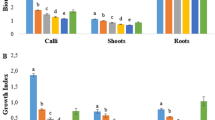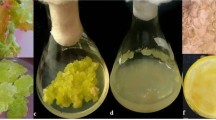Abstract
Salvia leriifolia Benth. (Lamiaceae) is an endangered medicinal plant with hypoglycemic, anti-inflammatory and analgesic properties. Many of the beneficial effects of Salvia spp. are attributed to the phenolic compounds. In the present study, an efficient procedure has been developed for establishment of cell suspension culture of S. leriifolia as a strategy to obtain an in vitro phenolic acids producing cell line for the first time. The effect of growth regulators and various concentrations of sucrose have been analyzed, to optimize biomass growth and phenolic acids production. The callus used for this purpose was obtained from leaves of 15-day-old in vitro seedlings, on Murashige and Skoog (MS) basal medium supplemented with different hormone balances including benzylaminopurine (BAP) and indole butyric acid (IBA); 2,4-dichlorophenoxyacetic acid (2,4-D) and kinetin (KIN); naphthaleneacetic acid (NAA) and BAP. Modified MS medium supplemented with 5 mg/L BAP and 5 mg/L NAA was the optimal condition for callus formation with the highest induction rate (100%), the best callus growth and the highest phenolic acids content. No callus induction was observed in combinations of IBA and BAP. Cell suspension cultures were established by transferring 0.5 g of callus to 30 mL liquid MS medium supplemented with 5 mg/L BAP and 5 mg/L NAA. Dynamics of phenolic acids production has been investigated during the growth cycle of the suspension cultures. The maximum content of caffeic acid and salvianolic acid B were observed on the 15th day of the cultivation cycle while the highest amount of rosmarinic acid was observed on the first day. In response to various sucrose concentrations, cell cultures with 40 g/L sucrose not only produced the highest dry biomass but also the highest induction of caffeic acid and salvianolic acid B. The highest amount of rosmarinic acid was observed in media containing 50 g/L sucrose. These prepared cell suspension cultures provided a useful system for further enhanced production of phenolic acids at a large scale.



Similar content being viewed by others
References
Ali M, Abbasi BH, Ahmad N, Ali SS, Ali S, Ali GS (2016) Sucrose-enhanced biosynthesis of medicinally important antioxidant secondary metabolites in cell suspension cultures of Artemisia absinthium L. Bioprocess Biosyst Eng 39:1945–1954
Bauer N, Leljak-Levanic D, Jelaska S (2004) Rosmarinic acid synthesis in transformed callus culture of Coleus blumei Benth. Zeitschrift für Naturforschung C 59:554–560
Bolta Z, Baricevic D, Bohanec B, Andrensek s (2000) A preliminary investigation of ursolic acid in cell suspension culture of Salvia officinalis. Plant Cell, Tissue Organ Cult 62:57–63
Dong J, Wan G, Liang Z (2010) Accumulation of salicylic acid-induced phenolic compounds and raised activities of secondary metabolic and antioxidative enzymes in Salvia miltiorrhiza cell culture. J Biotechnol 148:99–104
Gamaro GD, Suyenaga E, Borsoi M, Lermen J, Pereira P, Ardenghi P (2011) Effect of rosmarinic and caffeic acids on inflammatory and nociception process in rats. ISRN Pharmacol 10:1–6
Gertlowski C, Petersen M (1993) Influence of the carbon source on growth and rosmarinic acid production in suspension cultures of Coleus blumei. Plant Cell, Tissue Organ Cult 34:183–190
Ghorbani A, Esmaeilizadeh M (2017) Pharmacological properties of Salvia officinalis and its components. J Tradit Complement Med 7:433–440
Grzegorczyk I, Bilichowski I, Mikiciuk-Olasik E, Wysokinska H (2005) In vitro cultures of Salvia officinalis L. as a source of antioxidant compounds. Acta Soc Bot Pol 74:17–21
Grzegorczyk I, Matkowski A, Wysokińska H (2007) Antioxidant activity of extracts from in vitro cultures of Salvia officinalis L. Food Chem 104:536–541
Hippolyte I, Marin B, Baccou J, Jonard R (1992) Growth and rosmarinic acid production in cell suspension cultures of Salvia officinalis L. Plant Cell Rep 11:109–112
Hosseinzadeh H, Yavary M (1999) Anti-inflammatory effect of Salvia leriifolia Benth. leaf extract in mice and rats. Harm Pharmacol Lett 9:60–62
Huang L, Liu D, Hu Z (2000) Effects of phytohormones on growth and content of depsides in Salvia miltiorrhiza suspension cells. Zhong Yao Cai 2:1–4
Jalili A, Jamzad Z (1999) Red data book of Iran. A preliminary survey of endemic, rare and endangered plants species in Iran. RIFR Publication, Tehran
Karam NS, Jawad FM, Arikat NA, Shibl RA (2003) Growth and rosmarinic acid accumulation in callus, cell suspension, and root cultures of wild Salvia fruticosa. Plant Cell Tissue Organ Cult 73:117–121
Khanpour-Ardestani N, Sharifi M, Behmanesh M (2015) Establishment of callus and cell suspension culture of Scrophularia striata Boiss.: an in vitro approach for acteoside production. Cytotechnology 67:475–485
Kintzios S, Nikolaou A, Skoula M (1999) Somatic embryogenesis and in vitro rosmarinic acid accumulation in Salvia officinalis and S. fruticosa leaf callus cultures. Plant Cell Rep 18:462–466
Liu H, Guoping Z, Guozheng S, Songlin R, Qiaojuan F (2012) Callus induction and plant regeneration from mature seeds of Salvia splendens. Int J Agric Biol 14:445–452
Loizzo MR, Menichini F, Tundis R, Bonesi M, Conforti F, Nadjafi F, Menichini F (2009) In vitro biological activity of Salvia leriifolia Benth essential oil relevant to the treatment of Alzheimer’s disease. J Oleo Sci 58:443–446
Lu Y, Foo LY (2002) Polyphenolics of Salvia. Phytochem 59:117–140
Martinez B, Park C (1993) Characteristics of batch suspension cultures of preconditioned Coleus blumei cells: sucrose effect. Biotechnol Prog 9:97–100
Modarres M, Asili J, Lahouti M, Iranshahi M, Sahebkar A (2014) Simultaneous determination of rosmarinic acid, salvianolic acid B and caffeic acid in Salvia leriifolia Benth. root, leaf and callus extracts using a high-performance liquid chromatography with diode-array detection, technique. J Liq Chromatogr Relat Technol 37:1721–1730
Moore TC (1989) Biochemistry and physiology of plant hormones, vol 14. Springer, Berlin, pp 234–242
Murthy HN, Lee EJ, Peak KY (2014) Production of secondary metabolites from cell and organ cultures: strategies and approaches for biomass improvement and metabolite accumulation. Plant Cell Tissue Organ Cult 118:1–16
Owis AI, Abdelwahab NS, Abul-Soad AA (2016) Elicitation of phenolics from the micropropagated endangered medicinal plant Calligonum polygonoides L. (Polygonoaceae). Pharmacogn Mag 12:465–470
Petersen MS (1991) Characterization of rosmarinic acid synthase from cell cultures of Coleus blumei. Phytochem 30:2877–2881
Petersen M, Simmonds MS (2003) Rosmarinic acid. Phytochem 62:121–125
Rahayui S, Roostikai I, Bermawie N (2016) The effect of types and concentrations of auxins on callus induction of Centella asiatica. Nusantara Biosci 8:283–287
Rao SR, Ravishankar GA (2002) Plant cell cultures: chemical factories of secondary metabolites. Biotechnol Adv 20:101–153
Rechinger KH (1982) Flora Iranica, vol 150. Akademische Druck.u.Verlagsanstalt, Graz, Austria
Ren-Wang J, Kit-Man L, Po-Ming H, Thomas CW, Mak KS, Kwok-Pui F (2005) Chemistry and biological activities of caffeic acid derivatives from Salvia miltiorrhiza. Curr Med Chem 12:237–246
Sadeghnia H, Nassiri Asl M, Haddad Khodaparast M, Hosseinzadeh H (2003) The effect of Salvia leriifolia Benth. Root extracts on lipid peroxidation level during global ischemic-reperfusion in rats. J Med Plant 3:19–28
Santos-Gomes PC, Seabra RM, Andrade PB, Fernandes-Ferreira M (2003) Determination of phenolic antioxidant compounds produced by calli and cell suspensions of sage (Salvia officinalis L.). J Plant Physiol 160:1025–1032
Shimojo Y, Kosaka K, Noda Y, Shimizu T, Shirasawa T (2010) Effect of rosmarinic acid in motor dysfunction and life span in a mouse model of familial amyotrophic lateral sclerosis. J Neurosci Res 88:896–904
Su W, Humphrey AE (1990) Production of rosmarinic acid in high density perfusion cultures of Anchusa officinalis using a high sugar medium. Biotechnol Lett 12:793–798
Wang J, Xiong X, Feng B (2013) Cardiovascular effects of salvianolic acid B. Corporation evidence-based complementary and alternative medicine. Hindawi Publishing, Cairo, Egypt
Weremczuk-Jezyna I, Grzegorczyk-Karolak I, Frydrych B, Hnatuszko-Konka K, Gerszberg A, Wysokinska H (2017) Rosmarinic acid accumulation and antioxidant potential of Dracocephalum moldavica L. cell suspension culture. Not Bot Horti Agrobot 45:215–219
Wu CF, Karioti A, Rohr D, Bilia AR, Efferth T (2016) Production of rosmarinic acid and salvianolic acid B from callus culture of Salvia miltiorrhiza with cytotoxicity towards acutelymphoblastic leukemia cells. Food Chem 201:292–297
Yang SY, Hong C, Lee H, Park S, Park B, Lee K (2012) Protective effect of extracts of Perilla frutescens treated with sucrose on tert-butyl hydroperoxide-induced oxidative hepatotoxicity in vitro and in vivo. Food Chem 133:337–343
Yang D, Huang Z, Xing B, Jin W, Yan X, Guo Z, Liang Z (2016) Regulation of folic acid on phenolic acids production in Salvia miltiorrhiza hairy roots. Plant Cell Tissue Organ Cult 127:175–185
Acknowledgements
The authors thank the Ferdowsi University of Mashhad for providing equipments and facilities.
Author information
Authors and Affiliations
Contributions
This research paper was accomplished with the collaboration of all authors. Masoomeh Modarres contributed to the design of research, performed the experiments and wrote the manuscript; Sedighe Esmaeilzadeh Bahabadi supervised the study, wrote the manuscript and Mohammd Ehsan Taghavizadeh performed the experiments.
Corresponding author
Ethics declarations
Conflict of interest
The authors declare that they have no conflict of interest.
Rights and permissions
About this article
Cite this article
Modarres, M., Esmaeilzadeh Bahabadi, S. & Taghavizadeh Yazdi, M. Enhanced production of phenolic acids in cell suspension culture of Salvia leriifolia Benth. using growth regulators and sucrose. Cytotechnology 70, 741–750 (2018). https://doi.org/10.1007/s10616-017-0178-0
Received:
Accepted:
Published:
Issue Date:
DOI: https://doi.org/10.1007/s10616-017-0178-0




